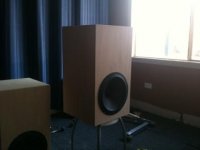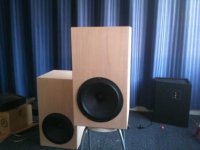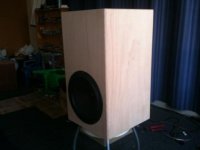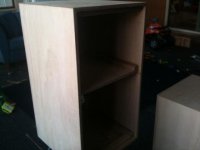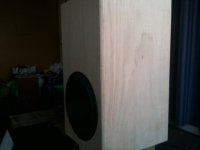effects of midrange enclosure qts pics inside !
g,day
i,m modeling an enclosure for a sealed mid design and are wondering about qts and its effects on sound
for instance bass = .5 is classed as a overdamped (tight) sound as compared to say .707
what should we use to model sealed mid enclosures ?
does the same rule apply
this is the driver i,m using http://www.solen.ca/pdf/veravox/veravox7x.pdf
it will be run as high as possible to a ss 2905 9900
and crossed to this vifa at around 1 to 200 hz Vifa NE315-W-04/HS
the vifa is run sealed qt .707
many thanks
g,day
i,m modeling an enclosure for a sealed mid design and are wondering about qts and its effects on sound
for instance bass = .5 is classed as a overdamped (tight) sound as compared to say .707
what should we use to model sealed mid enclosures ?
does the same rule apply
this is the driver i,m using http://www.solen.ca/pdf/veravox/veravox7x.pdf
it will be run as high as possible to a ss 2905 9900
and crossed to this vifa at around 1 to 200 hz Vifa NE315-W-04/HS
the vifa is run sealed qt .707
many thanks
Last edited:
i,m modeling an enclosure for a sealed mid design and are wondering about qts and its effects on sound
The higher the qts, the more EQ you normally need to get the desired frequency response. That often means thermal compression in an active speaker (as more watts are needed to get to a specific SPL below resonance). However a low qts raises compliance, so the driver is more prone to bottoming out on dynamic sequences. If the fs of the driver is high enough, the impedance peak near resonance can leak into a passive crossover's response, if the passive crossover is low enough.
If you want a value to shoot for for a midrange driver, then I suppose shoot for .45, but just realize that once you implement a crossover, the q itself didn't matter. The advantage to """.45 Q""" is only that you gave yourself room to place lots of insulation to eat up the backwave before it reflects back into the speaker cone. But of course that might mean you need to brace the box.
for instance bass = .5 is classed as a overdamped (tight) sound as compared to say .707
...or so "they say"... but that doesn't make it true or untrue until you verify it yourself, by making two different boxes, EQing both to the same anechoic frequency response, and listening with identical box placement in-room (or better yet, outdoors).
what should we use to model sealed mid enclosures ?
For a midrange, make it large enough that you can damp out the rear wave with fill. The acoustic slope should lend itself well to your crossover without sacrificing efficiency. Remember once a crossover is in place, qts goes out the window anyways, as the crossover has its own effect on Q. Always make a midrange as large as you can.
For a midwoofer, start at around qts = .6 and then model excursion for your intended power handling. If the driver is too easy to bottom out, raise qts until your amp clips before the driver bottoms. If qts goes over .8 you will start to get a hump in the frequency response that is not desirable. If F3 is above 100hz then you should not be using a sealed alignment for a midwoofer.
On a whole, qts is another one of those "holdovers" from a time before you could simulate the actual effect on frequency response. How much can you hear even a 1db peak in response, in a real room, in the bass where our ears are not very sensitive?
What most people mistake for qts, is "extension/power compression".
Last edited:
jeez that was quik
thanks Rocklee
the mid seems to sim well in 40 odd litres qts of .68 which would work out perfect for the cabs i have in mind which are 80 litres ,
40 litres of which i need for the bass drivers
the crossover is active via mini dsp
unibox suggests a vented cab but the size is 80 l and way too big to work for me
cheers
thanks Rocklee
the mid seems to sim well in 40 odd litres qts of .68 which would work out perfect for the cabs i have in mind which are 80 litres ,
40 litres of which i need for the bass drivers
the crossover is active via mini dsp
unibox suggests a vented cab but the size is 80 l and way too big to work for me
cheers
Far more important than Q, for a box are
1) Frequency response. Also realize that below 30hz most rooms have gain so you don't want to shoot for flat below 30hz.
2) Internal Standing waves. Does your box program simulate them? I recommend considering simulating with Martin J King's Transmission Line worksheets.
3) Baffle Diffraction. This is on the outside, not the inside, and far more likely to affect final SQ.
1) Frequency response. Also realize that below 30hz most rooms have gain so you don't want to shoot for flat below 30hz.
2) Internal Standing waves. Does your box program simulate them? I recommend considering simulating with Martin J King's Transmission Line worksheets.
3) Baffle Diffraction. This is on the outside, not the inside, and far more likely to affect final SQ.
hi
i,m using unibox to sim the drivers
the bass is sorted so this is for the mids from 100 hz up
the mid drivers i,m using are are fullrange drivers so i hope to let them run as low and high as possible and just use the tweeter and bass drivers as "fillers"
the driver positions on the baffle are still yet to be decided but the cabs are just about finnished so the baffle width anb height are set at 680mm high x 370mm wide
the main aim for the mid is to be as smooth and flat as possible and fit in a cab from 20 to 40 litres
cheers
i,m using unibox to sim the drivers
the bass is sorted so this is for the mids from 100 hz up
the mid drivers i,m using are are fullrange drivers so i hope to let them run as low and high as possible and just use the tweeter and bass drivers as "fillers"
the driver positions on the baffle are still yet to be decided but the cabs are just about finnished so the baffle width anb height are set at 680mm high x 370mm wide
the main aim for the mid is to be as smooth and flat as possible and fit in a cab from 20 to 40 litres
cheers
some more
the cabs are built around the bbc thin wall style
12mm marine ply with tassie oak frame(i could not find beech)
i still have to add the bitumen damping to the inside walls and once my mid drivers arrive i will finish routing the baffles
the bass drivers are vifa ne315, mids are veravox 7x which is a fullrange driver and i have scan 2905 9900 rev tweeters (i may change these for a super tweeter yet i,m not sure) any advice welcome
my inspiration for these are the 70,s style large bookshelf speakers like spendor and harbeth monitors
the system will be controled using my mini dsp
the cabs are built around the bbc thin wall style
12mm marine ply with tassie oak frame(i could not find beech)
i still have to add the bitumen damping to the inside walls and once my mid drivers arrive i will finish routing the baffles
the bass drivers are vifa ne315, mids are veravox 7x which is a fullrange driver and i have scan 2905 9900 rev tweeters (i may change these for a super tweeter yet i,m not sure) any advice welcome
my inspiration for these are the 70,s style large bookshelf speakers like spendor and harbeth monitors
the system will be controled using my mini dsp
Attachments
- Status
- This old topic is closed. If you want to reopen this topic, contact a moderator using the "Report Post" button.
- Home
- Loudspeakers
- Multi-Way
- effects of midrange enclosure qts
